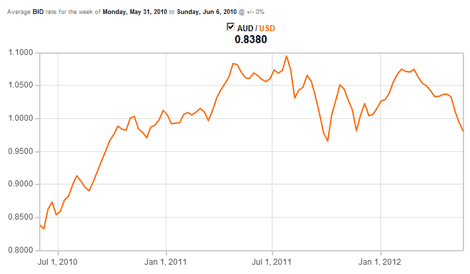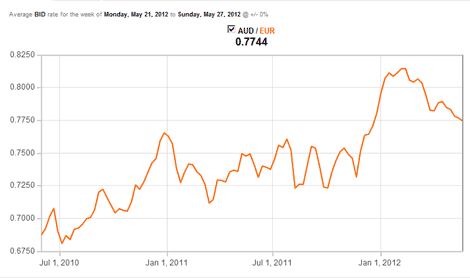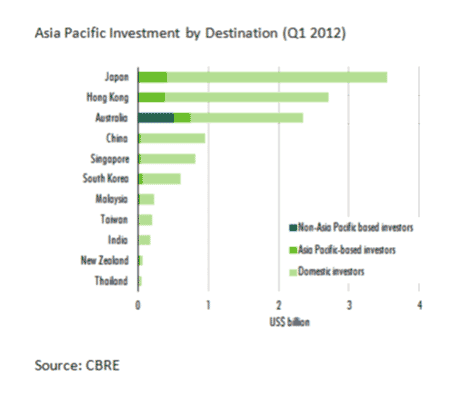Falling dollar encouraging even more offshore investment in Australian commercial property

Offshore investor demand for Australian commercial property, already strong, is likely to increase on the back of the weakening Australian dollar, say commercial property experts.
Savills has already noted anecdotal evidence of an up-tick in offshore demand as the dollar has fallen, “particularly from China, where the yuan is pegged to the US dollar”.
“We predict that further significant falls in the Australian dollar will lead to a surge in offshore investment in most forms of commercial properties, resulting in an escalation of values,” says Savills head of city sales and investments Clinton Baxter.
The Australian dollar reached parity with the US dollar in November 2010 and rose to a 29 year high of $1.108 on July 27 2011 before retreating.
Since the end of April 2012 the Australian dollar has decline from around $1.04 against the US dollar to below 98 cents with a more gradual decline commencing from the $1.09 level in February.
Australian dollar versus US dollar since July 2010

Source: OANDA.com
However, Baxter along with counterparts at Knight Frank and CBRE, notes that offshore investor demand has remained high even when the Australian dollar was at record levels.
“Despite the Australian dollar reaching record highs over the past two years, the Australian commercial property market has experienced an unprecedented flow of investment capital from off-shore, particularly from China and south-east Asia,” Baxter says.
“In the Melbourne CBD alone, half of all major transactions over the past 12 months have been to offshore investors.
“Counter-intuitively, motivation of offshore investors rose despite the protracted rise of the Australian dollar, with investors seeking a safe haven for their wealth, expansion into a new market, potential immigration advantage, and to invest in a country insulated from the woes of Europe and the US.”
Neil Brookes, director of international investments at CBRE, says the significant strengthening of the US dollar against the Australian dollar since February has positively affected buyers from the US and China.
“However the strengthening of the euro has not been as pronounced and therefore has not lessened the hedging costs for European investors,” he says.
Brookes says the volatility of the currency is a factor for some groups investing in Australia.
But he stresses that the majority of institutional buyers are looking at Australia as a long-term play and therefore aren’t sensitive to the currency variations.
Australian dollar versus euro since July 2010

Source: OANDA.com
Paul Henley, managing director of sales at Knight Frank, says there is already strong demand from offshore Asian private investors and institutions looking to invest and/or seek out development opportunities.
“The fall in the Australian dollar is only going to help,” he says.
Henley says investor interest is primarily coming from Asia, with the focus predominantly on the non-core office markets such as the St Kilda Road market in Melbourne and the North Sydney market.
“Investors are also seeking out development opportunities in Melbourne,” he says.
Henley says overseas buyers are seeking investments that represent a “strong return today” and will add value over time.
“They’re particurlarly targeting development opportunities in Melbourne.”
Henley says investors are looking to diversify their asset base and view Australia as a relatively stable economic climate.
“The Australian commercial market is not as foreign to these people as it was once – they are now very familiar with these markets.”
Before the strengthening of the dollar, Henley says Asian investors did not see the high exchange rate as an impediment.
“When the Australian dollar got to $1.05 against the US dollar we thought investor demand would slow down, but it didn’t slow down their appetite,” he says.
Earlier this month the ASX-listed iProperty Group launched a new Asian commercial property website, CommercialAsia.com, which includes Australian commercial properties among its listings.
According to Jones Lang LaSalle figures, Australian investment volumes for office, retail and industrial in the first quarter of 2012 reached $2.08 billion, compared with $1.4 billion in the first quarter of 2011. Australia was one of the top investment destinations for overseas buyers over this period – behind Japan and Hong Kong.
About a third of the investment in Australia has come from offshore, mainly from non-Asia Pacific investors.
In its recent Asia Pacific Capital Markets MarketView report, CBRE said A-grade offices in Sydney, Melbourne and Brisbane continued to attract a steady flow of enquiries. There was also a jump in demand for retail assets accounted for $968 million worth of deals during the period – 40% of total sales over the period.
